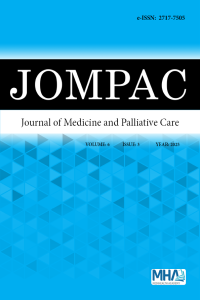Importance and comparison of inflammatory biomarkers in COVID-19 patients follow-up in intensive care unit
Öz
Aims: This study aimed to determine the power of laboratory parameters and biomarkers in predicting the prognosis of patients admitted to the intensive care units (ICU) with COVID-19 in a state hospital.
Methods: In this retrospective study, the hospital automation system of all patients admitted to Bolu İzzet Baysal State Hospital’s ICUs because of COVID-19 between March 2020 and December 2021 were recorded and examined. Demographic data, blood tests, APACHE II score, and inflammatory biomarkers were also recorded. The results of patients who survived and did not survive were compared.
Results: The study included 452 patients and the mortality was 72.6%. Exitus patients had higher APACHE II scores and age. The mortality rate was significantly higher in patients with neurological disorders. For patients who did not survive, blood leukocyte, procalcitonin, LDH, and creatinine levels were higher, whereas blood lymphocyte and thrombocyte levels were lower. Based on the ROC analyses, the lymphocyte count AUC was 0.624, APACHE II score AUC was 0.618, serum procalcitonin level AUC was 0.584, and platelet count was 0.560. Age, APACHE II score, neutrophil-to-lymphocyte ratio, and lymphocyte count were associated with mortality according to a univariate logistic regression analysis. Age (OR (95 CI%)1.02 (1.00-1.04, p=0.018)), APACHE II (OR (95 CI%)1.05 (1.01-1.09, p=0.018)), and neutrophil to lymphocyte ratio (OR (95 CI%) 1.02 (1.01-1.03, p=0.003)) were associated with mortality according to multivariate logistic regression
Conclusion: For patients admitted to the ICU, laboratory parameters and inflammatory biomarkers can help in diagnosis, follow-up, and prognosis in COVID-19. We believe that combinations of hemogram parameters are effective in predicting clinical follow-up and prognosis.
Anahtar Kelimeler
Intensive care unit mortality COVID-19 lymphocyte neutrophil-to-lymphocyte ratio
Etik Beyan
etik ihlal yoktur
Kaynakça
- Zhou F, Yu T, Du R, et al. Clinical course and risk factors for mortality of adult inpatients with COVID-19 in Wuhan, China: a retrospective cohort study. Lancet. 2020;395(10229):1054-1062. doi:10.1016/S0140-6736(20)30566-3
- Huang C, Wang Y, Li X, et al. Clinical features of patients infected with 2019 novel coronavirus in Wuhan, China. Lancet. 2020;395(10223):497-506. doi:10.1016/S0140-6736(20)30183-5
- Machado-Alba JE, Valladales-Restrepo LF, Machado-Duque ME, et al. Factors associated with admission to the intensive care unit and mortality in patients with COVID-19, Colombia. PLoS ONE. 2021;16(11): e0260169. doi:10.1371/journal.pone.0260169
- Kim L, Garg S, O'Halloran A, et al. Risk factors for intensive care unit admission and in-hospital mortality among hospitalized adults identified through the US coronavirus disease 2019 (COVID-19)-associated hospitalization surveillance network (COVID-NET). Clin Infect Dis. 2021;72(9):e206-e214. doi:10.1093/cid/ciaa1012
- Uzundere O, Kıvılcım Kaçar C, Erdal Erbatur M, et al. Yoğun bakım ünitesinde coronavirüs hastalığı-2019 olan kritik hastaların mortalitesini etkileyen faktörler. J Turk Soc Yoğun Bakım. 2021;19:54-61.
- Martins-Filho PR, Tavares CSS, Santos VS. Factors associated with mortality in patients with COVID-19. A quantitative evidence synthesis of clinical and laboratory data. Eur J Intern Med. 2020;76:97-99. doi:10. 1016/j.ejim.2020.04.043
- Lorente L, Martín MM, Argueso M, et al. Association between red blood cell distribution width and mortality of COVID-19 patients. Anaesth Crit Care Pain Med. 2021;40(1):100777. doi:10.1016/j.accpm.2020.10.013
- Konya PŞ, Demirtürk N, Korkmaz D, Tünay H, Koşar EB. Evaluation of clinical and laboratory characteristics and factors affecting mortality in 500 hospitalized COVID-19 patients: a retrospective study. Saudi Med J. 2022;43(11):1254-1259. doi:10.15537/smj.2022.43.11.20220641
- Lee J, Park SS, Kim TY, Lee DG, Kim DW. Lymphopenia as a biological predictor of outcomes in COVID-19 patients: a nationwide cohort study. Cancers (Basel). 2021;13(3):471. doi:10.3390/cancers13030471
- Toori KU, Qureshi MA, Chaudhry A. Lymphopenia: a useful predictor of COVID-19 disease severity and mortality. Pak J Med Sci. 2021;37(7): 1984-1988. doi:10.12669/pjms.37.7.4085
- Feng T, James A, Doumlele K, et al. Procalcitonin levels in COVID-19 patients are strongly associated with mortality and ICU acceptance in an underserved, inner city population. Medicina (Kaunas). 2021;57(10): 1070. doi:10.3390/medicina57101070
- Jackson I, Jaradeh H, Aurit S, et al. Role of procalcitonin as a predictor of clinical outcomes in hospitalized patients with COVID-19. Int J Infect Dis. 2022;119:47-52. doi:10.1016/j.ijid.2022.03.044
- Zattera L, Veliziotis I, Benitez-Cano A, et al. Early procalcitonin to predict mortality in critically ill COVID-19 patients: a multicentric cohort study. Minerva Anestesiol. 2022;88(4):259-271. doi:10.23736/S0375-9393.22.15942-0
- Imran MM, Ahmad U, Usman U, Ali M, Shaukat A, Gul N. Neutrophil/lymphocyte ratio-a marker of COVID-19 pneumonia severity. Int J Clin Pract. 2021;75(4):e13698. doi:10.1111/ijcp.13698
- King AH, Mehkri O, Rajendram P, Wang X, Vachharajani V, Duggal A. A high neutrophil-lymphocyte ratio is associated with increased morbidity and mortality in patients with coronavirus disease 2019. Crit Care Explor. 2021;3(5):e0444. doi:10.1097/CCE.0000000000000444
- Moradi EV, Teimouri A, Rezaee R, et al. Increased age, neutrophil-to-lymphocyte ratio (NLR) and white blood cells count are associated with higher COVID-19 mortality. Am J Emerg Med. 2021;40:11-14. doi:10. 1016/j.ajem.2020.12.003
- Yildiz H, Castanares-Zapatero D, Pierman G, et al. Validation of neutrophil-to-lymphocyte ratio cut-off value associated with high in-hospital mortality in COVID-19 patients. Int J Gen Med. 2021;14:5111-5117. doi:10.2147/IJGM.S326666
- Wang ZH, Fu BQ, Lin YW, et al. Red blood cell distribution width: a severity indicator in patients with COVID-19. J Med Virol. 2022;94(5): 2133-2138. doi:10.1002/jmv.27602
- Kalabin A, Mani VR, Valdivieso SC, Donaldson B. Does C reactive protein/albumin ratio have prognostic value in patients with COVID-19. J Infect Dev Ctries. 2021;15(8):1086-1093. doi:10.3855/jidc.14826
- El-Shabrawy M, Alsadik ME, El-Shafei M, et al. Interleukin-6 and C-reactive protein/albumin ratio as predictors of COVID-19 severity and mortality. Egypt J Bronchol. 2021;15(1):5. doi:10.1186/s43168-021-00054-1
- Milligan C, Atassi N, Babu S, et al. Tocilizumab is safe and tolerable and reduces C-reactive protein concentrations in the plasma and cerebrospinal fluid of ALS patients. Muscle Nerve. 2021;64(3):309-320. doi:10.1002/mus.27339
- Vicka V, Januskeviciute E, Miskinyte S, et al. Comparison of mortality risk evaluation tools efficacy in critically ill COVID-19 patients. BMC Infect Dis. 2021;21(1):1173. doi:10.1186/s12879-021-06866-2
- Ferrando C, Mellado-Artigas R, Gea A, et al. Patient characteristics, clinical course and factors associated to ICU mortality in critically ill patients infected with SARS-CoV-2 in Spain: a prospective, cohort, multicentre study. Rev Esp Anestesiol Reanim (Engl Ed). 2020;67(8):425-437. doi:10.1016/j.redar.2020.07.003
COVID-19 hastalarında yoğun bakım takibinde inflamatuvar biyobelirteçlerin önemi ve karşılaştırılması
Öz
Amaç: Bu çalışmanın amacı, bir devlet hastanesinde COVID-19 ile YBÜ'ye kabul edilen hastaların prognozunu öngörmede laboratuvar parametrelerinin ve biyobelirteçlerin gücünü belirlemektir.
Gereç ve Yöntemler: Bu retrospektif çalışmada, Mart 2020 ile Aralık 2021 tarihleri arasında Bolu İzzet Baysal Devlet Hastanesi YBÜ'lerine COVID-19 nedeniyle kabul edilen tüm hastaların hastane otomasyon sistemine kayıtları yapıldı ve incelendi. Demografik veriler, kan testleri, APACHE II skoru ve enflamatuar biyobelirteçler de kaydedildi. Hayatta kalan ve kalamayan hastaların sonuçları karşılaştırıldı.
Sonuçlar: Çalışmaya 452 hasta dahil edildi ve mortalite %72,6 idi. Exitus hastaların APACHE II skorları ve yaşları daha yüksekti. Nörolojik bozukluğu olan hastalarda mortalite oranı anlamlı derecede yüksekti. Hayatta kalamayan hastalarda kan lökosit, prokalsitonin, LDH ve kreatinin düzeyleri daha yüksek, kan lenfosit ve trombosit düzeyleri ise daha düşüktü. ROC analizlerine göre, lenfosit sayısı AUC 0,624, APACHE II skoru AUC 0,618, serum prokalsitonin düzeyi AUC 0,584 ve trombosit sayısı 0,560 olarak bulunmuştur. Tek değişkenli lojistik regresyon analizine göre yaş, APACHE II skoru, nötrofil/lenfosit oranı ve lenfosit sayısı mortalite ile ilişkiliydi.
Sonuç: YBÜ'ye kabul edilen hastalar için laboratuvar parametreleri ve enflamatuar biyobelirteçler COVID-19'da tanı, takip ve prognoza yardımcı olabilir. Hemogram parametrelerinin kombinasyonlarının klinik takip ve prognozu öngörmede etkili olduğuna inanıyoruz
Anahtar Kelimeler
Yoğın bakım Mortalite Covid-19 lenfosit lökosit lenfosit oranı
Kaynakça
- Zhou F, Yu T, Du R, et al. Clinical course and risk factors for mortality of adult inpatients with COVID-19 in Wuhan, China: a retrospective cohort study. Lancet. 2020;395(10229):1054-1062. doi:10.1016/S0140-6736(20)30566-3
- Huang C, Wang Y, Li X, et al. Clinical features of patients infected with 2019 novel coronavirus in Wuhan, China. Lancet. 2020;395(10223):497-506. doi:10.1016/S0140-6736(20)30183-5
- Machado-Alba JE, Valladales-Restrepo LF, Machado-Duque ME, et al. Factors associated with admission to the intensive care unit and mortality in patients with COVID-19, Colombia. PLoS ONE. 2021;16(11): e0260169. doi:10.1371/journal.pone.0260169
- Kim L, Garg S, O'Halloran A, et al. Risk factors for intensive care unit admission and in-hospital mortality among hospitalized adults identified through the US coronavirus disease 2019 (COVID-19)-associated hospitalization surveillance network (COVID-NET). Clin Infect Dis. 2021;72(9):e206-e214. doi:10.1093/cid/ciaa1012
- Uzundere O, Kıvılcım Kaçar C, Erdal Erbatur M, et al. Yoğun bakım ünitesinde coronavirüs hastalığı-2019 olan kritik hastaların mortalitesini etkileyen faktörler. J Turk Soc Yoğun Bakım. 2021;19:54-61.
- Martins-Filho PR, Tavares CSS, Santos VS. Factors associated with mortality in patients with COVID-19. A quantitative evidence synthesis of clinical and laboratory data. Eur J Intern Med. 2020;76:97-99. doi:10. 1016/j.ejim.2020.04.043
- Lorente L, Martín MM, Argueso M, et al. Association between red blood cell distribution width and mortality of COVID-19 patients. Anaesth Crit Care Pain Med. 2021;40(1):100777. doi:10.1016/j.accpm.2020.10.013
- Konya PŞ, Demirtürk N, Korkmaz D, Tünay H, Koşar EB. Evaluation of clinical and laboratory characteristics and factors affecting mortality in 500 hospitalized COVID-19 patients: a retrospective study. Saudi Med J. 2022;43(11):1254-1259. doi:10.15537/smj.2022.43.11.20220641
- Lee J, Park SS, Kim TY, Lee DG, Kim DW. Lymphopenia as a biological predictor of outcomes in COVID-19 patients: a nationwide cohort study. Cancers (Basel). 2021;13(3):471. doi:10.3390/cancers13030471
- Toori KU, Qureshi MA, Chaudhry A. Lymphopenia: a useful predictor of COVID-19 disease severity and mortality. Pak J Med Sci. 2021;37(7): 1984-1988. doi:10.12669/pjms.37.7.4085
- Feng T, James A, Doumlele K, et al. Procalcitonin levels in COVID-19 patients are strongly associated with mortality and ICU acceptance in an underserved, inner city population. Medicina (Kaunas). 2021;57(10): 1070. doi:10.3390/medicina57101070
- Jackson I, Jaradeh H, Aurit S, et al. Role of procalcitonin as a predictor of clinical outcomes in hospitalized patients with COVID-19. Int J Infect Dis. 2022;119:47-52. doi:10.1016/j.ijid.2022.03.044
- Zattera L, Veliziotis I, Benitez-Cano A, et al. Early procalcitonin to predict mortality in critically ill COVID-19 patients: a multicentric cohort study. Minerva Anestesiol. 2022;88(4):259-271. doi:10.23736/S0375-9393.22.15942-0
- Imran MM, Ahmad U, Usman U, Ali M, Shaukat A, Gul N. Neutrophil/lymphocyte ratio-a marker of COVID-19 pneumonia severity. Int J Clin Pract. 2021;75(4):e13698. doi:10.1111/ijcp.13698
- King AH, Mehkri O, Rajendram P, Wang X, Vachharajani V, Duggal A. A high neutrophil-lymphocyte ratio is associated with increased morbidity and mortality in patients with coronavirus disease 2019. Crit Care Explor. 2021;3(5):e0444. doi:10.1097/CCE.0000000000000444
- Moradi EV, Teimouri A, Rezaee R, et al. Increased age, neutrophil-to-lymphocyte ratio (NLR) and white blood cells count are associated with higher COVID-19 mortality. Am J Emerg Med. 2021;40:11-14. doi:10. 1016/j.ajem.2020.12.003
- Yildiz H, Castanares-Zapatero D, Pierman G, et al. Validation of neutrophil-to-lymphocyte ratio cut-off value associated with high in-hospital mortality in COVID-19 patients. Int J Gen Med. 2021;14:5111-5117. doi:10.2147/IJGM.S326666
- Wang ZH, Fu BQ, Lin YW, et al. Red blood cell distribution width: a severity indicator in patients with COVID-19. J Med Virol. 2022;94(5): 2133-2138. doi:10.1002/jmv.27602
- Kalabin A, Mani VR, Valdivieso SC, Donaldson B. Does C reactive protein/albumin ratio have prognostic value in patients with COVID-19. J Infect Dev Ctries. 2021;15(8):1086-1093. doi:10.3855/jidc.14826
- El-Shabrawy M, Alsadik ME, El-Shafei M, et al. Interleukin-6 and C-reactive protein/albumin ratio as predictors of COVID-19 severity and mortality. Egypt J Bronchol. 2021;15(1):5. doi:10.1186/s43168-021-00054-1
- Milligan C, Atassi N, Babu S, et al. Tocilizumab is safe and tolerable and reduces C-reactive protein concentrations in the plasma and cerebrospinal fluid of ALS patients. Muscle Nerve. 2021;64(3):309-320. doi:10.1002/mus.27339
- Vicka V, Januskeviciute E, Miskinyte S, et al. Comparison of mortality risk evaluation tools efficacy in critically ill COVID-19 patients. BMC Infect Dis. 2021;21(1):1173. doi:10.1186/s12879-021-06866-2
- Ferrando C, Mellado-Artigas R, Gea A, et al. Patient characteristics, clinical course and factors associated to ICU mortality in critically ill patients infected with SARS-CoV-2 in Spain: a prospective, cohort, multicentre study. Rev Esp Anestesiol Reanim (Engl Ed). 2020;67(8):425-437. doi:10.1016/j.redar.2020.07.003
Ayrıntılar
| Birincil Dil | İngilizce |
|---|---|
| Konular | Yoğun Bakım |
| Bölüm | Research Articles [en] Araştırma Makaleleri [tr] |
| Yazarlar | |
| Yayımlanma Tarihi | 18 Haziran 2025 |
| Gönderilme Tarihi | 3 Mart 2025 |
| Kabul Tarihi | 12 Nisan 2025 |
| Yayımlandığı Sayı | Yıl 2025 Cilt: 6 Sayı: 3 |
|
|
|
|
|
|
Dergimiz; TR-Dizin ULAKBİM, ICI World of Journal's, Index Copernicus, Directory of Research Journals Indexing (DRJI), General Impact Factor, Google Scholar, Researchgate, WorldCat (OCLC), CrossRef (DOI), ROAD, ASOS İndeks, Türk Medline İndeks, Eurasian Scientific Journal Index (ESJI) ve Türkiye Atıf Dizini'nde indekslenmektedir.
EBSCO, DOAJ, OAJI, ProQuest dizinlerine müracaat yapılmış olup, değerlendirme aşamasındadır.
Makaleler "Çift-Kör Hakem Değerlendirmesi”nden geçmektedir.
Üniversitelerarası Kurul (ÜAK) Eşdeğerliği: Ulakbim TR Dizin'de olan dergilerde yayımlanan makale [10 PUAN] ve 1a, b, c hariç uluslararası indekslerde (1d) olan dergilerde yayımlanan makale [5 PUAN].
Note: Our journal is not WOS indexed and therefore is not classified as Q.
You can download Council of Higher Education (CoHG) [Yüksek Öğretim Kurumu (YÖK)] Criteria) decisions about predatory/questionable journals and the author's clarification text and journal charge policy from your browser. About predatory/questionable journals and journal charge policy
Not: Dergimiz WOS indeksli değildir ve bu nedenle Q sınıflamasına dahil değildir.
Yağmacı/şüpheli dergilerle ilgili Yüksek Öğretim Kurumu (YÖK) kararları ve yazar açıklama metni ile dergi ücret politikası: Yağmacı/Şaibeli Dergiler ve Dergi Ücret Politikası












